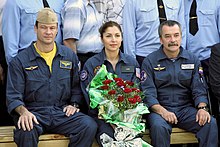Soyuz TMA-9
 | |
| Operator | Roskosmos |
|---|---|
| COSPAR ID | 2006-040A |
| SATCAT no. | 29400 |
| Mission duration | 215 days, 8 hours, 22 minutes |
| Spacecraft properties | |
| Spacecraft type | Soyuz-TMA 11F732 |
| Manufacturer | RKK Energia |
| Launch mass | 7,270 kilograms (16,030 lb) |
| Crew | |
| Crew size | 3 |
| Members | Mikhail Tyurin Michael López-Alegría |
| Launching | Anousheh Ansari |
| Landing | Charles Simonyi |
| Callsign | Vostok |
| Start of mission | |
| Launch date | 18 September 2006, 04:08 UTC |
| Rocket | Soyuz-FG |
| Launch site | Baikonur 1/5 |
| End of mission | |
| Landing date | 21 April 2007, 12:31 UTC |
| Orbital parameters | |
| Reference system | Geocentric |
| Regime | Low Earth |
| Perigee altitude | 200 kilometres (120 mi) |
| Apogee altitude | 242 kilometres (150 mi) |
| Inclination | 51.67 degrees |
| Period | 88.64 minutes[1] |
| Docking with ISS | |
| Docking port | Zvezda aft |
| Docking date | 20 September 2006 05:21 UTC |
| Undocking date | 10 October 2006 19:14 UTC |
| Time docked | 20d 13h 53m |
| Docking with ISS (Relocation) | |
| Docking port | Zarya nadir |
| Docking date | 10 October 2006 19:34 UTC |
| Undocking date | 29 March 2007 23:30 UTC |
| Time docked | 170d 3h 56m |
| Docking with ISS (Relocation) | |
| Docking port | Zvezda aft |
| Docking date | 29 March 2007 23:54 UTC |
| Undocking date | 21 April 2007 09:11 UTC |
| Time docked | 22d 9h 17m |

 Crew of Soyuz TMA-9: (l-r) López-Alegría, Ansari, Tyurin Soyuz programme (Crewed missions) | |

Soyuz TMA-9 was a Soyuz mission to the International Space Station (ISS) launched by a Soyuz FG launch vehicle. It was a human spaceflight mission transporting personnel to and from the ISS. It launched from the Baikonur Cosmodrome on 18 September 2006 at 08:09 MSD (04:09 UTC), docked with the ISS at 09:21 MSD (05:21 UTC) on 20 September, and returned to Earth on 21 April 2007. Soyuz TMA-9 transported two-thirds of ISS Expedition 14 to the space station along with one "spaceflight participant" who performed several experiments on behalf of the European Space Agency. [2]
Crew[]
| Position | Launching crew | Landing crew |
|---|---|---|
| Commander | Expedition 14 Second spaceflight | |
| Flight Engineer | Expedition 14 Fourth spaceflight | |
| Spaceflight Participant | Only spaceflight Tourist |
First spaceflight Tourist |
Crew notes[]
Daisuke Enomoto was originally scheduled to be the spaceflight participant, but on 21 August 2006, he was determined to be unfit for the flight due to medical reasons, and replaced by Anousheh Ansari, his back-up crew member.
Docking with ISS[]

- Docked to ISS: 20 September 2006, 05:21 UTC (to aft port of Zvezda)
- Undocking from ISS: 10 October 2006 19:14 UTC (from aft port of Zvezda)
- Docking to ISS: 10 October 2006 19:34 UTC (to nadir port of Zarya)
- Undocking from ISS: 29 March 2007 23:30 UTC (from nadir port of Zarya)
- Docking to ISS: 29 March 2007 23:54 UTC (to aft port of Zvezda)
- Undocking from ISS: 21 April 2007 09:11 UTC (from aft port of Zvezda)
Mission highlights[]
Soyuz TMA-9, known within the International Space Station program as ISS Soyuz 13, was the 32nd crewed flight to the ISS. It is of note because for three days, from 18–21 September 2006, it marked the first time since before the Columbia accident that twelve humans have been in space simultaneously; three aboard the International Space Station (Expedition 13), three aboard Soyuz TMA-9, and six aboard Space Shuttle Atlantis, flying mission STS-115.
The capsule successfully launched from Baikonur Cosmodrome in Kazakhstan on a Soyuz-FG rocket at 09:08 MDS (04:08 UTC) on Monday 18 September 2006.[3] It successfully docked with the ISS on Wednesday 20 September to begin a six-month stay on the orbiting laboratory.
Anousheh Ansari, the Spaceflight Participant launched by TMA-9, has returned to Earth safely alongside Commander Pavel Vinogradov and Flight Engineer Jeffrey Williams of the Expedition 13 crew aboard Soyuz TMA-8 on 29 September 2006 at 01:13 UTC. Undocking from the ISS took place at 21:53 UTC on 28 September. López-Alegría and Tyurin undocked from ISS on 21 April 2007, 09:11 UTC, and landed at 12:31:30 UTC, after a seven-month stay on the station.
When the capsule landed after 215 days in space, exceeding the 210-day warranty for Soyuz TMA spacecraft, it concluded the longest flight by a Soyuz spacecraft.[citation needed]
References[]
- ^ "Soyuz TMA-9 Launch". Archived from the original on September 27, 2007. Retrieved 2006-09-23.
- ^ "ESA experiments with spaceflight participant Ansari to ISS". Retrieved 2006-09-22.
- ^ "Soyuz TMA-9 - NSSDC ID: 2006-040A". National Space Science Data Center.
External links[]
- Crewed Soyuz missions
- Spacecraft launched in 2006
- Orbital space tourism missions
- Spacecraft which reentered in 2007
- Spacecraft launched by Soyuz-FG rockets


